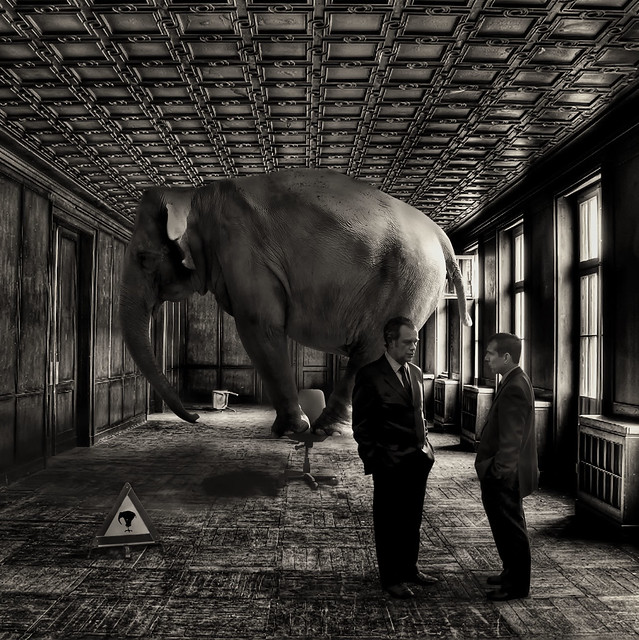Posts Tagged ‘Understanding Physics’
The Most Important People in Your Company
 When the fate of your company rests on a single project, who are the three people you’d tap to drag that pivotal project over the finish line? And to sharpen it further, ask yourself “Who do I want to lead the project that will save the company?” You now have a list of the three most important people in your company. Or, if you answered the second question, you now have the name of the most important person in your company.
When the fate of your company rests on a single project, who are the three people you’d tap to drag that pivotal project over the finish line? And to sharpen it further, ask yourself “Who do I want to lead the project that will save the company?” You now have a list of the three most important people in your company. Or, if you answered the second question, you now have the name of the most important person in your company.
The most important person in your company is the person that drags the most important projects over the finish line. Full stop.
When the project is on the line, the CEO doesn’t matter; the General Manager doesn’t matter; the Business Leader doesn’t matter. The person that matters most is the Project Manager. And the second and third most important people are the two people that the Project Manager relies on.
Don’t believe that? Well, take a bite of this. If the project fails, the product doesn’t sell. And if the product doesn’t sell, the revenue doesn’t come. And if the revenue doesn’t come, it’s game over. Regardless of how hard the CEO pulls, the product doesn’t launch, the revenue doesn’t come, and the company dies. Regardless of how angry the GM gets, without a product launch, there’s no revenue, and it’s lights out. And regardless of the Business Leader’s cajoling, the project doesn’t cross the finish line unless the Project Manager makes it happen.
The CEO can’t launch the product. The GM can’t launch the product. The Business Leader can’t launch the product. Stop for a minute and let that sink in. Now, go back to those three sentences and read them out loud. No, really, read them out loud. I’ll wait.
When the wheels fall off a project, the CEO can’t put them back on. Only a special Project Manager can do that.
There are tools for project management, there are degrees in project management, and there are certifications for project management. But all that is meaningless because project management is alchemy.
Degrees don’t matter. What matters is that you’ve taken over a poorly run project, turned it on its head, and dragged it across the line. What matters is you’ve run a project that was poorly defined, poorly staffed, and poorly funded and brought it home kicking and screaming. What matters is you’ve landed a project successfully when two of three engines were on fire. (Belly landings count.) What matters is that you vehemently dismiss the continuous improvement community on the grounds there can be no best practice for a project that creates something that’s new to the world. What matters is that you can feel the critical path in your chest. What matters is that you’ve sprinted toward the scariest projects and people followed you. And what matters most is they’ll follow you again.
Project Managers have won the hearts and minds of the project team.
The Project manager knows what the team needs and provides it before the team needs it. And when an unplanned need arises, like it always does, the project manager begs, borrows, and steals to secure what the team needs. And when they can’t get what’s needed, they apologize to the team, re-plan the project, reset the completion date, and deliver the bad news to those that don’t want to hear it.
If the General Manager says the project will be done in three months and the Project Manager thinks otherwise, put your money on the Project Manager.
Project Managers aren’t at the top of the org chart, but we punch above our weight. We’ve earned the trust and respect of most everyone. We aren’t liked by everyone, but we’re trusted by all. And we’re not always understood, but everyone knows our intentions are good. And when we ask for help, people drop what they’re doing and pitch in. In fact, they line up to help. They line up because we’ve gone out of our way to help them over the last decade. And they line up to help because we’ve put it on the table.
Whether it’s IoT, Digital Strategy, Industry 4.0, top-line growth, recurring revenue, new business models, or happier customers, it’s all about the projects. None of this is possible without projects. And the keystone of successful projects? You guessed it. Project Managers.
Image credit – Bernard Spragg .NZ
When The Wheels Fall Off
 When your most important product development project is a year behind schedule (and the schedule has been revved three times), who would you call to get the project back on track?
When your most important product development project is a year behind schedule (and the schedule has been revved three times), who would you call to get the project back on track?
When the project’s unrealistic cost constraints wall of the design space where the solution resides, who would you call to open up the higher-cost design space?
When the project team has tried and failed to figure out the root cause of the problem, who would you call to get to the bottom of it?
And when you bring in the regular experts and they, too, try and fail to fix the problem, who would you call to get to the bottom of getting to the bottom of it?
When marketing won’t relax the specification and engineering doesn’t know how to meet it, who would you call to end the sword fight?
When engineering requires geometry that can only be made by a process that manufacturing doesn’t like and neither side will give ground, who would you call to converge on a solution?
When all your best practices haven’t worked, who would you call to invent a novel practice to right the ship?
When the wheels fall off, you need to know who to call.
If you have someone to call, don’t wait until the wheels fall off to call them. And if you have no one to call, call me.
Image credit — Jason Lawrence
The Five Hardships of Success
 Everything has a half-life, but we don’t behave that way. Especially when it comes to success. The thinking goes – if it was successful last time, it will be successful next time. So, do it again. And again. It’s an efficient strategy – the heavy resources to bring it to life have already been spent. And it’s predictable – the same customers, the same value proposition, the same supply base, the same distribution channel, and the same technology. And it’s dangerous.
Everything has a half-life, but we don’t behave that way. Especially when it comes to success. The thinking goes – if it was successful last time, it will be successful next time. So, do it again. And again. It’s an efficient strategy – the heavy resources to bring it to life have already been spent. And it’s predictable – the same customers, the same value proposition, the same supply base, the same distribution channel, and the same technology. And it’s dangerous.
Success is successful right up until it isn’t. It will go away. But it will take time. A successful product line won’t fall off the face of the earth overnight. It will deliver profits year-over-year and your company will come to expect them. And your company will get hooked on the lifestyle enabled by those profits. And because of the addiction, when they start to drop off the company will do whatever it takes to convince itself all is well. No need to change. If anything, it’s time to double-down on the successful formula.
Here’s a rule: When your successful recipe no longer brings success, it’s not time to double-down.
Success’s decline will be slow, so you have time. But creating a new recipe takes a long time, so it’s time to declare that the decline has already started. And it’s time to learn how to start work on the new recipe.
Hardship 1 – Allocate resources differently. The whole company wants to spend resources on the same old recipes, even when told not to. It’s time to create a funding stream that’s independent of the normal yearly planning cycle. Simply put, the people at the top have to reallocate a part of the operating budget to projects that will create the next successful platform.
Hardship 2 – Work differently. The company is used to polishing the old products and they don’t know how to create new ones. You need to hire someone who can partner with outside companies (likely startups), build internal teams with a healthy disrespect for previous success, create mechanisms to support those teams and teach them how to work in domains of high uncertainty.
Hardship 3 – See value differently. How do you provide value today? How will you provide value when you can’t do it that way? What is your business model? Are you sure that’s your business model? Which elements of your business model are immature? Are you sure? What is the next logical evolution of how you go about your business? Hire someone to help you answer those questions and create projects to bring the solutions to life.
Hardship 4 – Measure differently. When there’s no customer, no technology and no product, there’s no revenue. You’ve got to learn how to measure the value of the work (and the progress) with something other than revenue. Good luck with that.
Hardship 5 – Compensate differently. People that create something from nothing want different compensation than people that do continuous improvement. And you want to move quickly, violate the status quo, push through constraints and create whole new markets. Figure out the compensation schemes that give them what they want and helps them deliver what you want.
This work is hard, but it’s not impossible. But your company doesn’t have all the pieces to make it happen. Don’t be afraid to look outside your company for help and partnership.
Image credit — Insider Monkey
Companies, Acquisitions, Startups, and Hurricanes
If you run a company, the most important thing you can control is how you allocate your resources. You can’t control how the people in your company will respond to input, but you can choose the projects they work on. You can’t control which features and functions your customers will like, but you can choose which features and functions become part of the next product. And you can’t control if a new technology will work, but you can choose the design space to investigate. The open question – How to choose in a way that increases your probability of success?
If you want to buy a company, the most important thing you can control is how you allocate your resources. In this case, the resources are your hard-earned money and your choice is which company to buy. The open question – How to choose in a way that increases your probability of success?
If you want to invest in a startup company, the most important thing you can control is how you allocate your resources. This case is the same as the previous one – your money is the resource and the company you choose defines how you allocate your resources. This one is a little different in that the uncertainty is greater, but so is the potential reward. Again, the same open question – How to choose in a way that increases your probability of success?
Taking a step back, the three scenarios can be generalized into a category called a “system.” And the question becomes – how to understand the system in a way that improves resource allocation and increases your probability of success?
These people systems aren’t predictable in an if-A-then-B way. But they do have personalities or dispositions. They’ve got characteristics similar to hurricanes. A hurricane’s exact path cannot be forecasted, the meteorologist can use history and environmental conditions to broadly define regions where the probability of danger is higher. The meteorologist continually monitors the current state of the hurricane (the system as it is) and tracks its position over time to get an idea of its trajectory (a system’s momentum). The key to understanding where the hurricane could go next: where it is right now (current state), how it got there (how it has behaved over time), and how have other hurricanes tracked under similar conditions (its disposition). And it’s the same for systems.
To improve your understanding of how your system may respond, understand it as it is. Define the elements and how those elements interact. Then, work backward in time to understand previous generations of the system. Which elements were improved? Which ones were added? Then, like the meteorologist, start at the system’s genesis and move forward to the present to understand its path. Use the knowledge of its path and the knowledge of systems (it’s important to be the one that improves the immature elements of the system and systems follow S-curves until the S-curve flattens) to broadly define regions where the probability of success is higher.
These methods won’t guarantee success. But, they will help you choose projects, choose acquisitions, choose technologies, and choose startups in a way that increases your probability of success.
Image credit — Alexander Gerst
Seeing Things as They Can’t Be
 When there’s a big problem, the first step is to define what’s causing it. To do that, based on an understanding of the physics, a sequence of events is proposed and then tested to see if it replicates the problem. In that way, the team must understand the system as it is before the problem can be solved.
When there’s a big problem, the first step is to define what’s causing it. To do that, based on an understanding of the physics, a sequence of events is proposed and then tested to see if it replicates the problem. In that way, the team must understand the system as it is before the problem can be solved.
Seeing things as they are. The same logic applies when it’s time to improve an existing product or service. The first thing to do is to see the system as it is. But seeing things as they are is difficult. We have a tendency to see things as we want them or to see them in ways that make us look good (or smart). Or, we see them in a way that justifies the improvements we already know we want to make.
To battle our biases and see things as they are, we use tools such as block diagrams to define the system as it is. The most important element of the block diagram is clarity. The first revision will be incorrect, but it must be clear and explicit. It must describe things in a way that creates a singular understanding of the system. The best block diagrams can be interpreted only one way. More strongly, if there’s ambiguity or lack of clarity, the thing has not yet risen to the level of a block diagram.
The block diagram evolves as the team converges on a single understanding of things as they are. And with a diagram of things as they are, a solution is readily defined and validated. If when tested the proposed solution makes the problem go away, it’s inferred that the team sees things as they are and the solution takes advantage of that understanding to make the problem go away.
Seeing things as they may be. Even whey the solution fixes the problem, the team really doesn’t know if they see things as they are. Really, all they know is they see things as they may be. Sure, the solution makes the problem go away, but it’s impossible to really know if the solution captures the physics of failure. When the system is large and has a lot of moving parts, the team cannot see things as they are, rather, they can only see the system as it may be. This is especially true if the system involves people, as people behave differently based on how they feel and what happened to them yesterday.
There’s inherent uncertainty when working with larger systems and systems that involve people. It’s not insurmountable, but you’ve got to acknowledge that your understanding of the system is less than perfect. If your company is used to solving small problems within small systems, there will be little tolerance for the inherent uncertainty and associated unpredictability (in time) of a solution. To help your company make the transition, replace the language of “seeing things as they are” with “seeing things as they may be.” The same diagnostic process applies, but since the understanding of the system is incomplete or wrong, the proposed solutions cannot not be pre-judged as “this will work” and “that won’t work.” You’ve got to be open to all potential solutions that don’t contradict the system as it may be. And you’ve got to be tolerant of the inherent unpredictability of the effort as a whole.
Seeing things as they could be. To create something that doesn’t yet exist, something does things like never before, something altogether new, you’ve got to stand on top of your understanding of the system and jump off. Whether you see things as they are or as they may be, the new system will be different. It’s not about diagnosing the existing system; it’s about imagining the system as it could be. And there’s a paradox here. The better you understand the existing system, the more difficulty you’ll have imagining the new one. And, the more success the company has had with the system as it is, the more resistance you’ll feel when you try to make the system something it could be.
Seeing things as they could be takes courage – courage to obsolete your best work and courage to divest from success. The first one must be overcome first. Your body creates stress around the notion of making yourself look bad. If you can create something altogether better, why didn’t you do it last time? There’s a hit to the ego around making your best work look like it’s not all that good. But once you get over all that, you’ve earned the right to go to battle with your organization who is afraid to move away from the recipe responsible for all the profits generated over the last decade.
But don’t look at those fears as bad. Rather, look at them as indicators you’re working on something that could make a real difference. Your ego recognizes you’re working on something better and it sends fear into your veins. The organization recognizes you’re working on something that threatens the status quo and it does what it can to make you stop. You’re onto something. Keep going.
Seeing things as they can’t be. This is rarified air. In this domain you must violate first principles. In this domain you’ve got to run experiments that everyone thinks are unreasonable, if not ill-informed. You must do the opposite. If your product is fast, your prototype must be the slowest. If the existing one is the heaviest, you must make the lightest. If your reputation is based on the highest functioning products, the new offering must do far less. If your offering requires trained operators, the new one must prevent operator involvement.
If your most seasoned Principal Engineer thinks it’s a good idea, you’re doing it wrong. You’ve got to propose an idea that makes the most experienced people throw something at you. You’ve got to suggest something so crazy they start foaming at the mouth. Your concepts must rip out their fillings. Where “seeing things as they could be” creates some organizational stress, “seeing things as they can’t be” creates earthquakes. If you’re not prepared to be fired, this is not the domain for you.
All four of these domains are valuable and have merit. And we need them all. If there’s one message it’s be clear which domain you’re working in. And if there’s a second message it’s explain to company leadership which domain you’re working in and set expectations on the level of uncertainty and unpredictability of that domain.
Image credit – David Blackwell.
Wanting things to be different

Wanting things to be different is a good start, but it’s not enough. To create conditions for things to move in a new direction, you’ve got to change your behavior. But with systems that involve people, this is not a straightforward process.
To create conditions for the system to change, you must understand the system”s disposition – the lines along which it prefers to change.. And to do that, you’ve got to push on the system and watch its response. With people systems, the response is not knowable before the experiment.
If you expect to be able to predict how the system will respond, working with people systems can be frustrating. I offer some guidance here. With this work, you are not responsible for the system’s response, you are only responsible for how you respond to the system’s response.
If the system responds in a way you like, turn that experiment into a project to amplify the change. If the system responds in a way you dislike, unwind the experiment. Here’s a simple mantra – do more of what works and less of what doesn’t. (Thanks to Dave Snowden for this.)
If you don’t like how things are going, you have only one lever to pull. You can only change.your response to what you see and experience. You can respond by pushing on the system and responding to what you see or you can respond by changing what you think and feel about the system.
But keep in mind that you are part of the system. And maybe the system is running an experiment on you. Either way, your only choice is to choose how to respond.
The Courage To Speak Up
 If you see things differently than others, congratulations. You’re thinking for yourself.
If you see things differently than others, congratulations. You’re thinking for yourself.
If you find yourself pressured into thinking like everyone else, that’s a sign your opinion threatens. It’s too powerful to be dismissed out-of-hand, and that’s why they want to shut you up.
If the status quo is angered by your theory, you’re likely onto something. Stick to your guns.
If your boss doesn’t want to hear your contrarian opinion, that’s because it cannot be easily dismissed. That’s reason enough to say it.
If you disagree in a meeting and your sentiment is actively dismissed, dismiss the dismisser. And say it again.
If you’re an active member of the project and you are not invited to the meeting, take it as a compliment. Your opinion is too powerful to defend against. The only way for the group-think to survive is to keep you away from it. Well done.
If your opinion is actively and repeatedly ignored, it’s too powerful to be acknowledged. Send a note to someone higher up in the organization. And if that doesn’t work, send it up a level higher still. Don’t back down.
If you look into the future and see a train wreck, set up a meeting with the conductor and tell them what you see.
When you see things differently, others will try to silence you and tell you you’re wrong. Don’t believe them. The world needs people like you who see things as they are and have the courage to speak the truth as they see it.
Thank you for your courage.
Image credit – Cristian V.
Ask for the right work product and the rest will take care of itself.
 We think we have more control than we really have. We imagine an idealized future state and try desperately to push the organization in the direction of our imagination. Add emotional energy, define a rational approach, provide the supporting rationale and everyone will see the light. Pure hubris.
We think we have more control than we really have. We imagine an idealized future state and try desperately to push the organization in the direction of our imagination. Add emotional energy, define a rational approach, provide the supporting rationale and everyone will see the light. Pure hubris.
What if we took a different approach? What if we believed people want to do the right thing but there’s something in the way? What if like a log jam in a fast-moving river, we remove the one log blocking them all? What if like a river there’s a fast-moving current of company culture that wants to push through the emotional log jam that is the status quo? What if it’s not a log at all but, rather, a Peter Principled executive that’s threatened by the very thing that will save the company?
The Peter Principled executive is a tough nut to crack. Deeply entrenched in the powerful goings on of the mundane and enabled by the protective badge of seniority, these sticks-in-the-mud need to be helped out of the way without threatening their no-longer-deserved status. Tricky business.
Rule 1: If you get into an argument with a Peter Principled executive, you’ll lose.
Rule 2: Don’t argue with Peter Principled executive.
If we want to make it easy for the right work to happen, we’ve got to learn how to make it easy for the Peter Principled executive to get out of the way. First, ask yourself why the executive is in the way. Why are they blocking progress? What’s keeping them from doing the right thing? Usually it comes down to the fear of change or the fear of losing control. Now it’s time to think of a work product that will help make the case there’s a a better way. Think of a small experiment to demonstrate a new way is possible and then run the experiment. Don’t ask, just run it. But the experiment isn’t the work product. The work product is a short report that makes it clear the new paradigm has been demonstrated, at least at small scale. The report must be clear and dense and provide objective evidence the right work happened by the right people in the right way. It must be written in a way that preempts argument – this is what happened, this is who did it, this is what it looks like and this is the benefit.
It’s critical to choose the right people to run the experiment and create the work product. The work must be done by someone in the chain of command of the in-the-way executive. Once the work product is created, it must be shared with an executive of equal status who is by definition outside the chain of command. From there, that executive must send a gracious email back into the chain of command that praises the work, praises the people who did it and praises the leader within the chain of command who had the foresight to sponsor such wonderful work.
As this public positivity filters through the organization, more people will add their praise of the work and the leaders that sponsored it. And by the time it makes it up the food chain to the executive of interest, the spider web of positivity is anchored across the organization and can’t be unwound by argument. And there you have it. You created the causes and conditions for the log jam to unjam itself. It’s now easy for the executive to get out of the way because they and their organization have already been praised for demonstrating the new paradigm. You’ve built a bridge across the emotional divide and made it easy for the executive and the status quo to cross it.
Asking for the right work product is a powerful skill. Most error on the side of complication and complexity, but the right work product is just the opposite – simple and tight. Think sledgehammer to the forehead in the form of and Excel chart where the approach is beyond reproach; where the chart can be interpreted just one way; where the axes are labeled; and it’s clear the status quo is long dead.
Business model is dead and we’ve got to stop trying to keep it alive. It’s time to break the log jam. Don’t be afraid. Create the right work product that is the dynamite that blows up the status quo and the executives clinging to it.
Image credit – Emilio Küffer
Is your tank empty?
 Sometimes your energy level runs low. That’s not a bad thing, it’s just how things go. Just like a car’s gas tank runs low, our gas tanks, both physical and emotional, also need filling. Again, not a bad thing. That’s what gas tanks are for – they hold the fuel.
Sometimes your energy level runs low. That’s not a bad thing, it’s just how things go. Just like a car’s gas tank runs low, our gas tanks, both physical and emotional, also need filling. Again, not a bad thing. That’s what gas tanks are for – they hold the fuel.
We’re pretty good at remembering that a car’s tank is finite. At the start of the morning commute, the car’s fuel gauge gives a clear reading of the fuel level and we do the calculation to determine if we can make it or we need to stop for fuel. And we do the same thing in the evening – look at the gauge, determine if we need fuel and act accordingly. Rarely we run the car out of fuel because the car continuously monitors and displays the fuel level and we know there are consequences if we run out of fuel.
We’re not so good at remembering our personal tanks are finite. At the start of the day, there are no objective fuel gauges to display our internal fuel levels. The only calculation we make – if we can make it out of bed we have enough fuel for the day. We need to do better than that.
Our bodies do have fuel gages of sorts. When our fuel is low we can be irritable, we can have poor concentration, we can be easily distracted. Though these gages are challenging to see and difficult to interpret, they can be used effectively if we slow down and be in our bodies. The most troubling part has nothing to do with our internal fuel gages. Most troubling is we fail to respect their low fuel warnings even when we do recognize them. It’s like we don’t acknowledge our tanks are finite.
We don’t think our cars are flawed because their fuel tanks run low as we drive. Yet, we see the finite nature of our internal fuel tanks as a sign of weakness. Why is that? Rationally, we know all fuel tanks are finite and their fuel level drops with activity. But, in the moment, when are tanks are low, we think something is wrong with us, we think we’re not whole, we think less of ourselves.
When your tank is low, don’t curse, don’t blame, don’t feel sorry and don’t judge. It’s okay. That’s what tanks do.
A simple rule for all empty tanks – put fuel in them.
Image credit – Hamed Saber
How to Choose the Best Idea
 We have too many ideas, but too few great ones. We don’t need more ideas, we need a way to choose the best one or two ideas and run them to ground.
We have too many ideas, but too few great ones. We don’t need more ideas, we need a way to choose the best one or two ideas and run them to ground.
Before creating more ideas, make a list of the ones you already have. Put them in two boxes. In Box 1, list the ideas without a video of a functional prototype in action. In Box 2, list the ideas that have a video showing a functional prototype demonstrating the idea in action. For those ideas with a functional prototype and no video, put them in Box 1.
Next, throw away Box 1. If it’s not important enough to make a crude physical prototype and create a simple video, the idea isn’t worth a damn. If someone isn’t willing to carve out the time to make a physical prototype, there’s no emotional energy behind the idea and it should be left to die. And when people complain that it’s unfair to throw away all those good ideas in Box 1, tell them it’s unfair to spend valuable resources talking about ideas that aren’t worthy. And suggest, if they want to have a discussion about an idea, they should build a physical prototype and send you the video. Box 2, or bust.
Next, get the band together and watch the short videos in Box 2, and, as a group, put them in two boxes. In Box 3, put the videos without customers actively using the functional prototype. In Box 4, put the videos with customers actively using the functional prototype.
Next, throw way Box 3. If it’s not important enough to make a trip to an important customer and create a short video, the idea isn’t worth a damn. If you’re not willing to put yourself out there and take the idea to an important customer, the idea is all fizzle and no sizzle. Meaningful ideas take immense personal energy to run through the gauntlet, and without a video of a customer using the functional prototype, there’s not enough energy behind it. And when everyone argues that Box 3 ideas are worth pursuing, tell them to pursue a video showing a most important customer demonstrating the functional prototype.
Next, get the band back together to watch the Box 4 videos. Again, put the videos in two boxes. In Box 5 put the videos where the customer didn’t say what they liked and how they’d use it. In Box 6, put the videos where the customer enthusiastically said what they liked and how they’ll use it.
Next, throw away Box 5. If the customer doesn’t think enough about the prototype to tell you how they’ll use it, it’s because they don’t think much of the idea. And when the group says the customer is wrong or the customer doesn’t understand what the prototype is all about, suggest they create a video where a customer enthusiastically explains how they’d use it.
Next, get the band back in the room and watch the Box 6 videos. Put them in two boxes. In Box 7, put the videos that won’t radically grow the top line. In Box 8, put the videos that will radically grow the top line. Throw away Box 7.
For the videos in Box 8, rank them by the amount of top line growth they will create. Put all the videos back into Box 8, except the video that will create the most top line growth. Do NOT throw away Box 8.
The video in your hand IS your company’s best idea. Immediately charter a project to commercialize the idea. Staff it fully. Add resources until adding resources doesn’t no longer pulls in the launch. Only after the project is fully staffed do you put your hand back into Box 8 to select the next best idea.
Continually evaluate Boxes 1 through 8. Continually throw out the boxes without the right videos. Continually choose the best idea from Box 8. And continually staff the projects fully, or don’t start them.
Image credit – joiseyshowaa
How to Avoid a Cliff
 Much like living organisms continually evolve to secure their place in the future, technological systems can be thought to display similar evolutionary behavior. Viruses mutate so some of them can defeat the countermeasures of their host and live to fight another day. Technological systems, as an expression of a company’s desire to survive, evolve to defeat the competition and live to pay another dividend.
Much like living organisms continually evolve to secure their place in the future, technological systems can be thought to display similar evolutionary behavior. Viruses mutate so some of them can defeat the countermeasures of their host and live to fight another day. Technological systems, as an expression of a company’s desire to survive, evolve to defeat the competition and live to pay another dividend.
There are natural limits to evolutionary success in any single direction. When one trait is improved it pushes on the natural limits imposed by the environment. For example, a bacterium let loose in a friendly Petri dish will replicate until it eats all the food in the dish. Or, on a longer timescale, if the mass of a bird increases over generations when its food source is plentiful, the bird will get larger but will also get less agile. The predators who couldn’t catch the fast, little bird of old can easily catch and eat the sluggish heavyweight. In that way, there’s an edge condition created by the environmental Petri dishes and predators. And it’s the same with technological systems.
Companies and their technological systems evolve within their competitive environment by scanning the fitness landscape and deciding where to try to improve. The idea is to see preferential lines of improvement and create new technologies to take advantage of them. Like their smaller biological counterparts, companies are minimum energy creatures and want to maximize reward (profit) with minimum effort (expense) and will continue to leverage successful lines of evolution until it senses diminishing returns.
The diminishing returns are a warning sign that the company is approaching an edge condition (a Petri dish of a finite size). In landscape lingo, there’s a cliff on the horizon. In technology lingo, the rate of improvement of the technology is slowing. In either language, the edge is near and it’s time to evolve in a new direction because this current one is out of gas.
Like the bird whose mass increases over the generations when food is readily available, companies also get fat and slow when they successfully evolve in a single direction for too long. And like the bird, they get eaten by a more agile competitor/predator. And just as the replication rate of the bacterium accelerates as the food in the Petri dish approaches zero, a company that doesn’t react to a slowing rate of technological improvement is sure to outlive its business model.
Biology and technology are similar in that they try new things (create variants of themselves) in order to live another day. But there’s a big difference – where biology is blind (it doesn’t know what will work and what won’t), technology is sighted (people that create use their understanding to choose the variants they think will work best). And another difference is that biological evolution can build only on viable variants where technology can use mental models as scaffolds to skip non-viable embodiments to cross a chasm.
There’s no need to fall off the cliff. As a leading indicator, monitor the rate of improvement of your technology. If its rate of improvement is still accelerating, it’s time to develop the next line of evolution. If its rate is declining, you waited too long. It’s time to double down on two new lines of evolution because you’re behind the curve. And remember, like with the population of bacteria in the Petri dish, sales will keep growing right up until the business model runs out of food or a competitor eats you.
Image credit — Amanda

 Mike Shipulski
Mike Shipulski